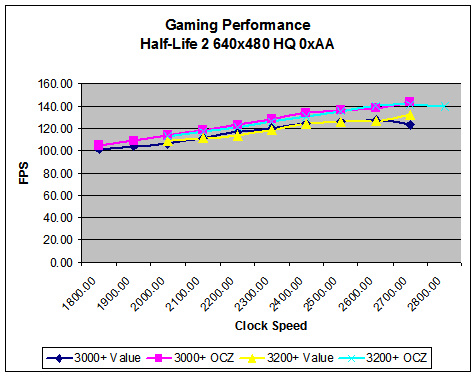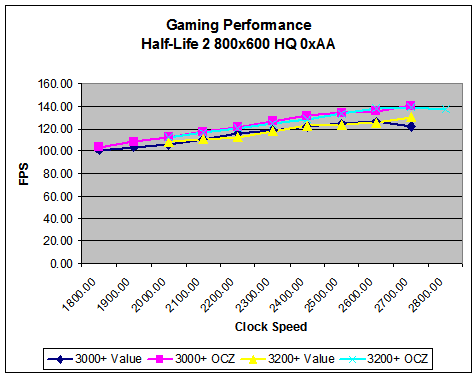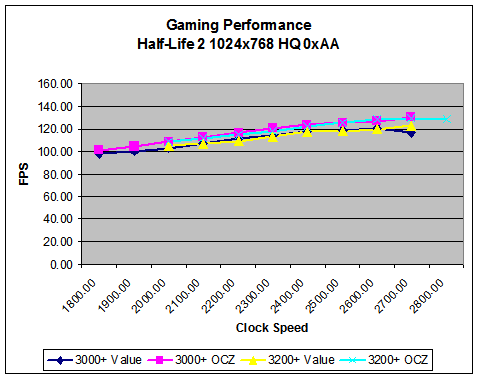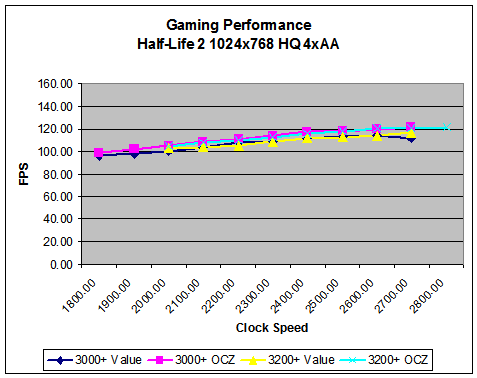Investigations into Socket 939 Athlon 64 Overclocking
by Jarred Walton on October 3, 2005 4:35 PM EST- Posted in
- CPUs
Half-Life 2 Performance
Just as Doom 3 favors NVIDIA performance, Half-Life 2 has done better on ATI cards. Our X800 Pro should provide more than playable results at all the tested resolutions, as HL2 really depends on GPU fillrate for performance. HL2 is also somewhat more CPU limited than other titles, which should give some good performance scaling with our overclocks. Future Source engine games making use of HDR will probably move the bottleneck back towards the GPU, judging by what we've seen in other HDR-enabled titles. Hopefully, Source can manage to provide more realistic HDR modes without cutting performance in half, but we're doubtful.
As with Far Cry, we benchmarked several levels and averaged the results; in this case, we used Anand's C17_12, Canals_08, Coast_05, Coast_12, and Prison_05 demos. Unfortunately, this may be the last time that we use those benchmarks, as the recent Steam upgrade has broken compatibility with revision 7 demos. All of these benchmarks were completed prior to the 9/23 update, luckily, but future overclocking articles will use different demos and will thus not be directly comparable with these scores. For the 22 graphs of the individual levels, we've once again created a Zip file.
In our biggest margin of victory, the OCZ RAM averages a 9% advantage over the value RAM. That's about the equivalent of a CPU upgrade (assuming that you don't overclock), at about the same cost as upgrading the processor. Like Far Cry, the 2T timing hurts performance. One of the things that you might have noticed is that the 10x280 setting has trailed behind the 2700 MHz configurations in most of the games. If we could get it running stably with 1T command rate, it would be better, but we were unable to accomplish this. The value RAM wouldn't even post at 10x280, so whatever limits that we're running into are at least lessened with higher quality RAM.
Just as Doom 3 favors NVIDIA performance, Half-Life 2 has done better on ATI cards. Our X800 Pro should provide more than playable results at all the tested resolutions, as HL2 really depends on GPU fillrate for performance. HL2 is also somewhat more CPU limited than other titles, which should give some good performance scaling with our overclocks. Future Source engine games making use of HDR will probably move the bottleneck back towards the GPU, judging by what we've seen in other HDR-enabled titles. Hopefully, Source can manage to provide more realistic HDR modes without cutting performance in half, but we're doubtful.
As with Far Cry, we benchmarked several levels and averaged the results; in this case, we used Anand's C17_12, Canals_08, Coast_05, Coast_12, and Prison_05 demos. Unfortunately, this may be the last time that we use those benchmarks, as the recent Steam upgrade has broken compatibility with revision 7 demos. All of these benchmarks were completed prior to the 9/23 update, luckily, but future overclocking articles will use different demos and will thus not be directly comparable with these scores. For the 22 graphs of the individual levels, we've once again created a Zip file.




In our biggest margin of victory, the OCZ RAM averages a 9% advantage over the value RAM. That's about the equivalent of a CPU upgrade (assuming that you don't overclock), at about the same cost as upgrading the processor. Like Far Cry, the 2T timing hurts performance. One of the things that you might have noticed is that the 10x280 setting has trailed behind the 2700 MHz configurations in most of the games. If we could get it running stably with 1T command rate, it would be better, but we were unable to accomplish this. The value RAM wouldn't even post at 10x280, so whatever limits that we're running into are at least lessened with higher quality RAM.










101 Comments
View All Comments
edlight - Tuesday, January 3, 2006 - link
I've found a way to overclock and retain the Power Now/Cool'n'Quiet.I let the motherboard do it's Cool'n'Quiet thing but I don't load the AMD driver. I run CrystalCPUID, which lets me set up the multiplier and voltage of each of the 3 cpu steps.
The voltage setting of the motherboard, for my Gigabyte, has to be on Auto for Crystal to be able to change it.
The highest Crystal can go with my 1.4v 3000+ Winnie is 1.45v.
This let me take it up to 3800+ -- a speed of 2.4. 240 x 10.
So it's running at 1.2 -- 240 x 5 -- most of the time. I set it at 1.2v there and froze it there and p95'd it overnight, as I did to the other 2 speeds.
For me this is a great compromise between running "cool 'n quiet" and high performance.
It's only a small percentage speed jump to 2.6, but requires alot of voltage and heat.
I can't say what the maximum voltage would be for a Venice. Crystal lets me choose higher voltages than 1.45, but it doesn't actually set them.
RaulAssis - Wednesday, December 21, 2005 - link
Some people reported that the Cool 'n' Quiet feature could work in a OC system. Maybe not all bioses support correct scaling of voltages when the system is OC and the Cool 'n' Quiet feature is turned on.JarredWalton - Wednesday, December 21, 2005 - link
With any moderate OC, CnQ is going to cause problems. It dynamically adjusts multipliers and voltages... something that will usually screw up an overclocked system. I would strongly discourage trying to use CnQ with an OC'ed setup. Some motherboard BIOSes actually disable CnQ automatically if you enable overclocking features.mrmoti - Wednesday, November 30, 2005 - link
If I understand correctly:Performance RAM running at DDR400 2-2-2-8 and Value RAM running at DDR400 2.5-3-3-8
At same OC on the processor, Performance RAM outperformed the Value RAM by 5% to 10%, being the price something between 80% to 100% more.
So, what's the impact of runnig faster memory at high lateny? Say DDR500 at 3-4-4-8
Because looking at the table of estimated latencies, (Performance) DDR400 2-2-2-5 has an estimated latency of 46.5, where (Value) DDR400 2.5-3-3-7 has an estimated latency of 49.75, an improve of 6.5% being in the range of 5% to 10% better.
By the same table, DDR500 3-4-4-8 has an estimated latency of 42.4, an improvement of 8.8% over the Performance DDR400 and 14.7% over the Value DDR400, based only in latencies.
Can anybody run a benchmark confirming/denying this?
Being the case that the price of DDR500 with those timings is in the middle between Performance and Value RAM
T Rush - Sunday, October 16, 2005 - link
One of the main focuses of this article seems to be value -vs- performance RAMs when over clocking, but you chose to run the performance RAM at settings where is doesn't perform, shame on you Jarred Walton, very disappointedIf you look at the settings you used to test the two RAMs at...
http://images.anandtech.com/reviews/cpu/amd/athlon...">http://images.anandtech.com/reviews/cpu...niceover...
...you see that the MAX speed you where able to run the OCZ Rev2 at was not in it's "performance envelope", as the OCZ Rev2 is one of the worst performers in this speed range http://www.anandtech.com/memory/showdoc.aspx?i=256...">http://www.anandtech.com/memory/showdoc.aspx?i=256... <OCZ Rev2 at 266MHz, and all the other "performance RAMs" beat it
But if you look at how the OCX Rev2 does work at much higher speeds, where it does perform...
http://www.anandtech.com/memory/showdoc.aspx?i=256...">http://www.anandtech.com/memory/showdoc.aspx?i=256...
...you find that it is performing much differently than what you tested at, and would have shown a much larger performance lead over the value RAM
How did you get this on to Anandtech? How could you show such a bad comparison of value -vs- performance RAM on a site which has always shown so much information about how these RAMs perform?
I not only blame you, but also the editors for not catching how badly you have managed to make performance RAM look. It is clear you were trying to prove that cheap RAM can falsely perform as well as high-end performance RAMs. If you truly wanted to show what performance RAM can do when over clocking you either needed to run the OCZ Rev2 at much faster speeds, or use a different performance RAM that works well at the sub 270MHz speeds you tested at.
JarredWalton - Sunday, October 16, 2005 - link
This is one set of RAM run through extensive tests on one platform. I've seen the same RAM run faster in some other systems, but not a whole lot. Just because some DIMMs reach DDR636 doesn't mean that all of them do. I could run this RAM at 3-4-4-8-2T timings at DDR600, but it actually ran worse than 2.5-3-3-8-1T with the lower memory ratio.What is clear is that I wasn't trying to "prove" anything. I was running some comparison tests with a system using two different types of RAM, and I'm sorry that you don't like the results. What I did prove was that someone one a budget could build a very fast system. An FX or San Diego core with higher quality RAM and a better motherboard would be better overall, but price/performance it would get stomped by this <$1000 setup.
T Rush - Monday, October 17, 2005 - link
I don't find the OCZ Rev2 to be a good example of the high performance RAM everyone thinks it is, as it doesn’t perform well at the speeds you (and most everyone else) use…not compared to other good over clocking RAMsGranted some of the other performance RAMs do cost much more than the value RAMs, and even more than the OCZ Rev2, but they would have shown a greater performance difference than the value RAM which in your tests was not able to run any faster than its stock rated speeds or timings
Your testing shows that running RAM at faster speeds adds very little performance over stock speed value RAM, and that is because the timings/speed relationships of that peculiar performance RAM at those peculiar higher speeds were not good.
As I said before, all the other performance RAMs beat it, and perform much better at speeds under 270MHz than the OCZ Rev2 does
Using the right RAM at the right speeds to run the best timings is the true art to over clocking, as RAM timings and speeds can allow the AMD64 to perform at much higher levels when over clocked
I do not disagree with your results, as that is how those RAMs perform:
Value RAM only being able to run its rated speeds and timings, not being able to over clock at all.
OCZ Rev2 running at higher speeds but with such bad timings that it shows very little performance gains unless you are able to run it at CAS 2.5 in the 300MHz range
I am not a fan of the OCZ Rev2 because of this, but I am a fan of performance RAM over value RAM, even on a budget system.
If you read clue22’s reply “so basically what the everybody is saying about the value RAM vs. low latency more expensive RAM is that for the athlon 64 it is basically a waste of money (i.e. you only get about 5% performance gain), but usually spend 100% or more money to get the "better" RAM.”
…and cyptonomicon’s “and its nice to see those ram comparisons. good to see those results on the latest a64 platform and confirm once again that the ram makes only a few percentage points difference”
…next intellon’s “I understand how/why the memory quality is not too imoprtant (5-9% increase for 100 bucks = not worthy)”
Clearly by using the OCZ Rev2 you did not show what spending a little bit more for better performing RAM can do. You have shown that running RAM at speeds with timings where it doesn’t perform well is a waste of money, but this does not answer any questions about value -vs- performance RAM
JarredWalton - Monday, October 17, 2005 - link
I've got X2 benchmarks with four different types of RAM in the works:OCZ VX
OCZ Plat Rev2 (TCCD)
Mushkin Value
PDP 2x1GB 2-3-2-5-1T
Other than the fact that 2GB of RAM helps out certain tasks (BF2 load times!), the total performance difference with those configurations is still not huge. With a 3.5V RAM voltage, the VX would do better, but even then the difference isn't above 10%.
T Rush - Thursday, October 20, 2005 - link
for a budget system I would say the socket 754 is better...as the motherboards and CPUs are cheaper...and you can get ClawHammer CPUs with the larger performance 1MB L2 cachethe only thing you miss out on with the 754 is the dual channel memory mode(which only adds very little performance anyway)...but by over clocking the core:memory speed you can easily match the performance gained by the greater bandwidth of the dual channel mode (this could be why the socket 939 doesn't show large gains from overclocking with the memory 'in-sync'..as it can't use all the bandwidth the faster memory gives)
with a mid-range system you could pick a 10X multi 3200+ Venice, or even a 11X multi 3500+ Venice(either of those would have a much better CPU multi for overclocking than the 3000+'s 9X multi) which would allow you to keep the HTT/HTL speed at a more reasonable level(270MHz and 245MHz to reach 2.7GHz CPU speed...where a 9X multi CPU would need a 300MHz HTT speed to run the CPU that fast)
...but the 3200+ and 3500+ are costing $190 to $250...so for not much more you could have a performance San Diego core on the 939 platform (3700+ 11X multi SD is only $267 now)
...so for $80 to $40 more I would go for the larger San Diego core...I would also spend the ~$20 more for CAS 2 RAM (over $90 Value RAM)...thats like just $100...for a computer with much better parts...and say you use this system for 18 months, that works out to less than $6 a month for a using higher quality parts
Deathcharge - Saturday, October 15, 2005 - link
Jarred this was a great article and did come at a great time as i am in the market for buying a bang for the buck system. One thing you didnt mention (although i saw that in the CPU-z screen shots) is the CPU steppinghttp://www.amdcompare.com/us-en/desktop/default.as...">http://www.amdcompare.com/us-en/desktop/default.as...
the 3200+ venice core comes in 3 different stepping and i belive the one you used in your article is the E3 stepping which is being replaced with the E6 stepping. Any info on how well the new stepping OC? initial reports from around the net indicate that it doesnt OC very well for some reason would love to read your comments on this.
Do you know if it is possible to OC to 2500 or 2600O with stock HSF as i would really like to save the money spent on the TT-90 and get a 7800GT (as opposed to x800xl). one final thing would OCZ value VX require active cooling?
thanks and keep up the good work, really enjoyed reading it and would look forward to future articles